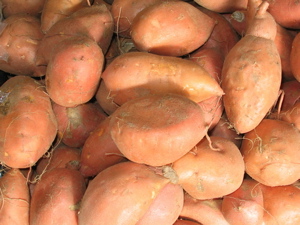Yam
 |
In the U.S., we often confuse our yams with orange sweet potatoes, but the two are not even horticulturally related. |
The hardy root offers an earthy taste and little sweetness, though most varieties contain more natural sugar and moisture than sweet potatoes.
In the United States, yams are frequently confused with orange-colored sweet potatoes, though the tubers are not horticulturally related.
History
Because yam growth spans the globe, it’s tough to pinpoint their origin. However, we do know they have been cultivated in Africa and Asia since at least 50,000 BC, where supporting livestock and growing leafy green vegetables presented a climactic challenge.The confusion between the yam and orange sweet potatoes in the United States stems from the early 20th century. Growers wanted to avoid confusion between the orange-fleshed sweet potato and the white-fleshed potato that Americans were familiar with, and took the word “yam” from the African word for this type of potato, “nyami.”
Varieties
There are between 150-200 varieties of yams, with flesh that varies from off-white to yellow and pink to purple and skin that varies from white to pink to brownish-black.Some specific, common yam varieties include the Hawaiian yam, the sweet yam and the Korean yam.
Yams are sold primarily fresh in the U.S.—most canned “yams” are actually sweet potatoes.
Buying Tips
• Yams are hard to come by in the United Sates, though sweet potatoes are often (incorrectly) labeled “yams”. If you find yams at your grocery store and are set on purchasing true yams, you should consider inquiring as to the origins to make sure you aren’t getting a sweet potato variety.• Yams sold in refrigerated produce sections should be avoided if possible, because the cold temperatures can alter the taste.
• Yams can be found in specialty markets and those that sell Latin American and Caribbean foods. They are often chopped into large chunks and wrapped in plastic because yams can grow very large (sometimes reaching 7 feet in length).
• Look for yams that feel firm with tight skin and firm flesh, without blemishes, cracks, or soft spots.
Storage Tips
Uncooked yams shouldn’t be refrigerated, but can be kept unrefrigerated for up to two weeks if stored in a cool, dry place. They should be stored loose (not wrapped up in a bag, which could trap moisture and encourage rotting). If exposed to temperatures above 50ºF, yams are more likely to decay and sprout.Cooked yams can be frozen for 10-12 months if packed in an airtight container with at least ½ inch of extra space, and they can be kept refrigerated for up to 3 days.
Usage Tips
• All yams (with the exception of the Japanese mountain yam, nagaimo) must be cooked before they are eaten because they contain toxins when raw that will make their consumers ill.• They can be cooked just like potatoes: steamed, boiled and mashed, fried or baked





